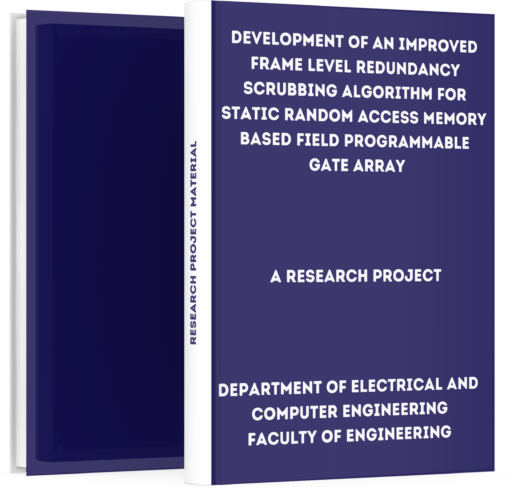Development of an Improved Frame Level Redundancy Scrubbing Algorithm for Static Random Access Memory Based Field Programmable Gate Array
₦3,000.00
If you are interested in getting this project material “Development of an Improved Frame Level Redundancy Scrubbing Algorithm for Static Random Access Memory Based Field Programmable Gate Array”, click on the DOWNLOAD BUTTON to make payment and the file will be delivered to your email immediately after confirmation.
Description
– Development of an Improved Frame Level Redundancy Scrubbing Algorithm for Static Random Access Memory Based Field Programmable Gate Array –
Download Development of an Improved Frame Level Redundancy Scrubbing Algorithm for Static Random Access Memory Based Field Programmable Gate Array. Electrical and Computer Engineering students who are writing their projects can get this material to aid their research work.
Abstract
The use of Static Random Access Memory (SRAM)-based Field Programmable Gate Array (FPGA) in critical applications has been considered a solution in the space and avionics domain due to its flexibility in achieving multiple requirements such as re-programmability and good performance.
However, SRAM-based FPGAs are susceptible to radiation-induced Single Event Upset (SEU) that affect the functionality of the implemented design.
This research presents the development of an improved Frame Level Redundancy (FLR) Scrubbing algorithm for SRAM-based FPGA to mitigate against radiation-induced SEU.
Introduction
Static random access memory (SRAM) based field-programmable gate arrays (FPGAs) are complementary metal-oxide-semiconductor (CMOS) devices with a special characteristic of reconfigurability making them desirable for use in systems with evolving technology (Jorge et al., 2015).
The use of FPGAs has been shown to provide high computational density and efficiency for many computing applications by allowing circuits to be customized to any application of interest (Wirthlin, 2015).
They are attractive to critical applications due to their high performance, power consumption, and reconfiguration capability (nonfat et al., 2015), and can be re-configured in the field, design updates can be performed while the device is still operational (kastensmidt & rech, 2016).
How to Download this Project Material
First, note that we are one of the best and most reliable online platforms because we don’t retain any of your personal information or data as regards making payments online.
PRICE: ₦3,500 ₦3,000 (Three Thousand Naira Only)
Make a bank deposit or mobile transfer of ₦2,000 only to the account given below;
Bank Name: UBA Account Number: 1022564031 Account Name: TMLT PRO SERVICES
After making the payment, CLICK HERE to send the following on WhatsApp;
- Depositor’s Name or Screenshot of Payment
- Name of the Past Question
- Active Email Address
or Call Us On +2348082284439 Once your details have been received and your payment confirmed by us, you will receive the past question in your email or WhatsApp within 5 Minutes.
Guarantee of Getting the Material
We understand that due to the high rate of fraud, many people are afraid of making purchases online but be rest assured that PastExamQuestions will deliver your material after payment.
Once your details have been received and your payment confirmed by us, you will receive the past question in your email or WhatsApp.
Give us Feedback
Have we been able to satisfy you? How well do you think the material will be helpful after having gone through it? Does the price worth the material?
Let’s hear from you! We recommend that our customers give feedback at the end of every transaction to enable us to serve better. You can do this by clicking the review button on this page.
Where is the review button? >> Just scroll up to where you see reviews





Reviews
There are no reviews yet.